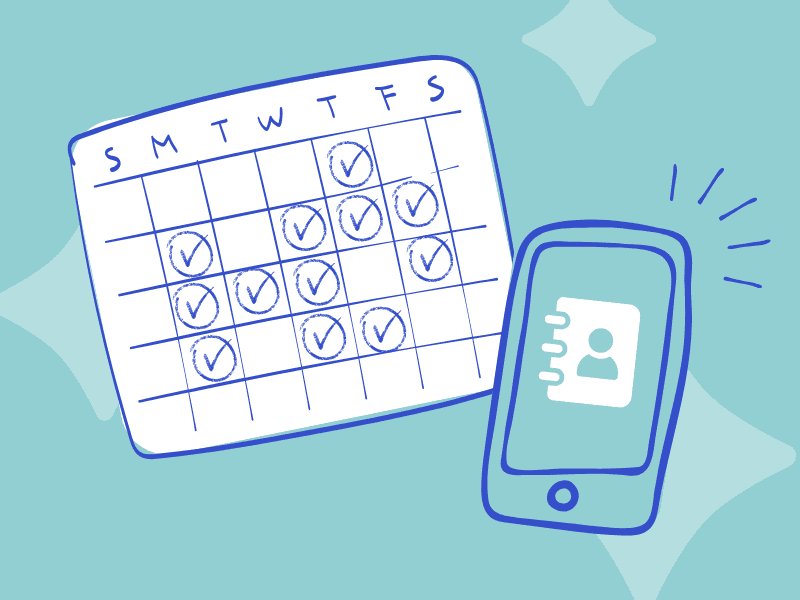Every phone call is an opportunity for your dental practice to convert interest into appointments and build trust with patients so they keep coming back. Even the most interested patients need proper communication to take that step. For group practices and DSOs, the stakes are even higher. With multiple locations and teams to manage, consistency matters. This is where call scripts can help.
Build Scripts That Feel Personal, Not Robotic
Why is it so important to implement call scripts for new patient lead generation for DSOs and group practices? They allow you and your staff to:
- Share consistent and accurate messaging with patients
- Reduce stress on staff
- Save time
- Take control of the conversation
Tips for creating effective scripts:
- Keep it short and simple
- Personalize the message
- Use a warm and friendly tone
- Be empathetic to your patients’ concerns
- Include all pertinent information
- Encourage booking with a soft close
Remember that call scripts are meant to guide the conversation, not dictate it. A good script leaves room for flexibility and allows staff to adjust the conversation based on the patient’s unique needs.

How to Adapt Scripts for Different Patient Types
To increase your patient call conversion, you should adjust your call scripts based on your patients’ needs and where they are in the patient journey.
- First-Time Patients: Focus on being warm, welcoming, and building trust. Address questions and inquiries clearly, and clearly explain what patients can expect from your clinic.
- Example: “We’d love to welcome you for your very first visit. Our team will walk you through each step so you feel completely comfortable.”
- Insurance-Savvy / Cost-Conscious Patients: Be clear, transparent, and helpful. Focus on explaining insurance coverage and payment options.
- Example: “We’ll verify your insurance for you so you know what’s covered before you come in. And if anything isn’t covered, we’ll go over payment options so you can choose what works best.”
- Nervous or Anxious Patients: Make sure your tone is calm, empathetic, and reassuring to ease the patient’s anxiety.
- Example: “You’re not alone. Many of our patients feel the same way. Our dentist is known for being very gentle, and we can talk through options to make sure you feel comfortable every step of the way.”
- Parents Calling for Their Children: Let parents know that your dental practice has experience treating children and focuses on safety and comfort.
- Example: “Dr. [Name] loves working with children. We make visits fun and stress-free so your child feels at ease.”
- Emergency Patients: Patients dealing with a dental emergency require fast action and a calm, reassuring presence.
- Example: “I’m so sorry you’re in pain. Let’s get you taken care of right away. We have a same-day slot available. Are you able to come in within the next hour?”
- Long-Time Patients: Always be helpful and show appreciation toward your long-term patients.
- Example: “Hi [Name], it’s so nice to hear from you again! We’d love to see you for your next visit. Let’s get you scheduled so you stay on track.”
Example Call Scripts
New Patient Appointment Booking
Use this script for callers who are interested in becoming new patients.
Front-end staff: Good morning/afternoon, thank you for calling [name of your practice]. My name is [name]. How can I help you today?
New patient: Hi, I’m wondering if you’re accepting new patients?
Front-end staff: Yes, absolutely! We’d be happy to welcome you as a new patient. Would you like to book your first appointment?
New patient: Sure.
Front-end staff: Ok, can I get your full name, phone number, and email?
New patient: My name is [name], my phone number is [number], and my email is [email address].
Front-end staff: Great, thank you so much [patient name]. We have availability on [a few options for date and time]. Which time slot would work best for you?
New patient: [date and time] would work best for me.
Front-end staff: Ok, perfect. I’ve booked you in for [date and time]. Do you have dental insurance that you’d like us to have on file, or will you be paying out of pocket?
New patient: [provides answer].
Front-end staff: Perfect, thank you. Before we end the call, is there anything else I can help you with, [patient name]?
New patient: No, that’s all for now. Thank you.
Front-end staff: Alright, thank you for choosing [dental practice name]. We look forward to seeing you soon.
Emergency Calls
Use this script to handle urgent cases such as a toothache, broken crown, knocked-out tooth, etc.
Front-end staff: Thank you for calling [dental practice name]. This is [name]. How can I help you today?
Patient: Hi, I have an emergency with my tooth. It’s really painful, and I don’t know what to do.
Front-end staff: I’m sorry you’re experiencing this. If you feel you need urgent care, please call 911. Otherwise, we can definitely help you. Can I get your name and phone number?
Patient: My name is [patient name], and my phone number is [phone number].
Front-end staff: Great, thank you. Now, can you tell me what happened, [patient name]?
Patient: [explains the situation].
Front-end staff: You did the right thing by calling. Our dentist can see you [today/within X hours]. Does that work for you?
Patient: Yes.
Front-end staff: Perfect, I’ve reserved [time] for you today. Before you come in, do you have dental insurance you’d like us to have on file, or will you be paying out of pocket?
Patient: [provides answer].
Front-end staff: Thank you. Please come in as soon as you can—we’ll be ready for you.
Patient Reactivation & Recall
Use this script to follow up with patients who haven’t been in for 6+ months.
Front-end staff: Hi [patient name], this is [your name] calling from [practice name]. How have you been?
Patient: I’m fine, thank you.
Front-end staff: We just wanted to check in because we noticed it’s been a while since your last cleaning and exam. We recommend visits every six months to keep your smile healthy. Would you like to schedule your next appointment? We have a few time slots available within the next two weeks.
Patient: Ok, do you have availability on [date and time]?
Front-end staff: Yes, we do. Let me book you in for [date and time].
Patient: Thank you. Can you also check if my insurance covers it?
Front-end staff: Yes, we can confirm your insurance benefits so you know what’s covered before you come in. Do you have any other questions, [patient name]?
Patient: No, that’s all, thank you.
Front-end staff: Great, we’ll see you on [date/time]. Have a lovely day. Thanks for choosing [dental practice name] to care for your smile.
Looking for an easy way to reactivate patients? 1-800-DENTIST’s PatientActivator enables practices to send automated emails and texts, streamlining communication and saving time for front-end staff.
Role-Playing Exercises to Boost Patient Call Conversion of Call Scripts
Once you’ve created call scripts, set aside time for your staff to practice with role-playing exercises with different scenarios so they can be prepared for real calls.
What are the benefits of role-playing call scripts?
- Helps staff build confidence in handling tough scenarios like objections, emergencies, or angry patients. The more they practice, the less flustered they’ll be during real calls.
- Makes scripts sound natural. Reading word-for-word can sound robotic. Role play lets team members personalize phrasing while still hitting key points.
- Reveals where staff can improve. This gives staff a chance to fix it before they’re on the phone with a patient.
Overcome Common Objections with Ease
Sometimes you’ll get pushback from patients as you try to book an appointment for them. This is an opportunity to provide value to the patient and show them that you care about their oral health. Let’s go through how to handle common objections and maximize your conversion rates.
Effectively Handling Price and Insurance Questions

If a patient says that a treatment or procedure is too expensive, the first thing your staff should do is acknowledge that they understand it’s a significant investment that shouldn’t be taken lightly.
Then gently remind them about the importance of the treatment to their oral health.
Here’s an example:
“I completely understand. Dental care can feel like a big investment. The good news is we’ll check your insurance coverage ahead of time so there are no surprises. And for anything not covered, we offer flexible payment options to make treatment affordable. Would you like me to walk you through those options?”
What if the patient doesn’t have insurance?
Position your practice as accessible and let them know you have different options to make treatment more affordable.
Here’s an example:“That’s okay! Many of our patients don’t have insurance. We offer an in-house membership plan that covers checkups, cleanings, and discounts on treatment. We also offer different payment plans. It helps keep costs predictable and much lower than paying out of pocket each time.”
Turning “I’ll Think About It” into a Confirmed Appointment
Sometimes patients will say, “I’ll think about it and get back to you”, but most of the time, if you let them go, they’re gone for good. The key is to acknowledge their concerns without pressure, then offer a low-friction next step.
For example, you can use the “hold the spot” technique:
“Of course, I understand. Why don’t I go ahead and reserve a spot for you now? That way, you’ll have it secured, and if you decide to change or reschedule, you can do that no problem. Would morning or afternoon work better?”
Or you can create scarcity and value:
“I completely understand. I just want to let you know our next openings are about [X days/weeks] out, and they tend to fill up quickly. If you’d like, we can secure one now so you don’t lose your place, and you can always change the timeslot later if needed.”
Measuring Script Effectiveness Across Locations
Creating call scripts is only half of the equation. With new patient lead generation for DSOs and group practices, the real value comes from understanding how well they’re being used across your locations. By tracking performance, you can identify what’s working, spot gaps, and ensure every one of your practices is delivering the same high-quality patient experience.
Using Software to Measure Effectiveness
Call tracking and analytics software make it possible to measure script effectiveness with hard data. These tools record and analyze inbound calls, so you can track key metrics like:
- Conversion rate: How many calls result in a booked appointment?
- Missed opportunities: Instances where a patient inquiry didn’t turn into a visit.
- Call handling quality: Was the script followed? Did the staff member show empathy and gather all necessary information?
- Trends by location: Which offices are consistently converting calls, and which ones need improvement.
Creating a Training Program for Locations That Are Falling Behind
Once you’ve identified which locations are underperforming, the next step is targeted training. Focus on helping each team overcome its unique challenges. Consider:
- Role-playing common scenarios: Give staff the chance to practice handling objections or difficult patient calls in a safe, low-pressure environment.
- Call reviews: Listen to real calls together and highlight what went well and where improvements can be made.
- Cheat sheets and quick references: Provide simple guides with objection-handling techniques and script reminders staff can keep by the phone.
- Mentorship and peer learning: Pair high-performing locations with lower-performing ones so teams can learn from each other’s strengths.
Use Simple Call Scripts to Increase Patient Call Conversion
Scripts are simple tools to empower front-end staff to handle different scenarios comfortably and effectively on the phone, making patients feel heard and supported. By creating clear, flexible guidelines, doing role-playing exercises, and measuring ongoing performance, DSOs and group practices can transform every phone call into an opportunity to build trust and grow their patient base.



